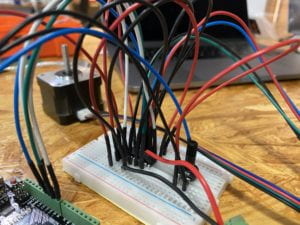Please answer each of these questions. Add your answers to your blog post, along with the other documentation for the circuits that you built in class.
Question 1: What kind of machines would you be interested in building? Add a reflection about the use of actuators, the digital manipulation of art, and the creative process to your blog post.
Question 2: Choose an art installation mentioned in the reading ART + Science NOW, Stephen Wilson (Kinetics chapter). Post your thoughts about it and make a comparison with the work you did during this recitation. How do you think that the artist selected those specific actuators for his project?
Answer 1: Speaking of what kind of machine I would feel interested in building, the first type of machine that comes up in my mind is the ones that can help the disabled’s life easier or to help them do something that they are not capable of doing by themselves. About how to achieve or actually build one machine for those purposes, I think I am going to use a lot of sensors. For instance, to help the blind sense whether there is any obstacle in their way, we need a lot of distance sensors to detect the objects around the user accurately and comprehensively. Also, we are going to need some sound output devices so that we can give the user feedbacks about our detected outcomes. Although this may not be a piece of art, we can actually use this experience to make the user draw a painting which is generated from their footsteps. By adding some pressure sensor on a certain area of ground, we can sense where the user goes, and based on that information, maybe together with how much pressure the user use to step on each piece of brick, we can create a colorful drawing whose color depends on the pressure level. In the process, I want to add a lot of creative and extraordinary experiences for the users, besides the basic function of detecting whether there is any obstacle in front of or around the blind users.
Answer 2: In the reading, there are a lot of interesting interactive projects that were done by good designers. Among all of those, I find out that the one titled Centripetal Sound Machines, created by designer Matt Heckert, intrigues me the most. First of all, I really like his key concept of making people feel like stand inside many machines. Besides, he is not simply displaying the machines from manufacturing industries, instead, he is using simple chairs with pipe strikes to create the sound similar to that produced by the manufacturing factories, which fascinates me a lot. Compared with the drawing machine I have done with my partner on the recitation, I think there are a lot of differences as well as commonalities. The first major difference is that we are creating a painting as our final outcome while he is producing sounds. Another important thing is that our drawing machine need to be controlled and operated by the users which can be regarded as a long-term active interaction. However, in this project, the art installation itself is able to create the whole soundscape, and all the users need to do is to experience by listening. As for similarities, I think both projects are producing simple things in a much more creative way with a new perspective. Last but not least, I think the reason why the author selects those specific actuators is that he wants to create sounds that are similar to manufacturing machines. Therefore, metal chairs and pipe strikes are ideal. In addition, pipe strikes are actually parts of the manufacturing machines, so they can represent for it.
Media Documentation:
Code for my drawing machine:
/* * MotorKnob * * A stepper motor follows the turns of a potentiometer * (or other sensor) on analog input 0. * * http://www.arduino.cc/en/Reference/Stepper * This example code is in the public domain. */ #include <Stepper.h> // change this to the number of steps on your motor #define STEPS 100 // create an instance of the stepper class, specifying // the number of steps of the motor and the pins it's // attached to Stepper stepper(STEPS, 8, 9, 10, 11); // the previous reading from the analog input int previous = 0; void setup() { // set the speed of the motor to 30 RPMs stepper.setSpeed(30); } void loop() { // get the sensor value int val = analogRead(0); val = map(val, 0, 1023, 0, 200); // move a number of steps equal to the change in the // sensor reading stepper.step(val - previous); // remember the previous value of the sensor previous = val; }
